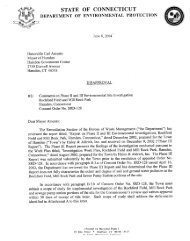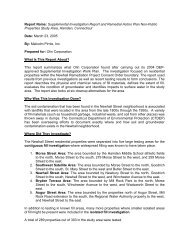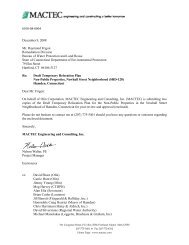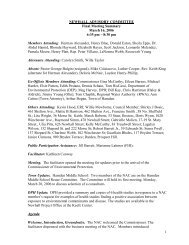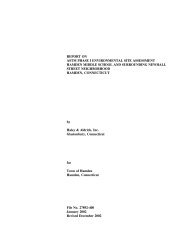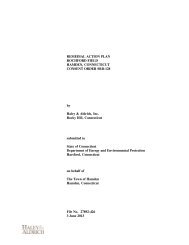Main Report - Newhall Remediation Project
Main Report - Newhall Remediation Project
Main Report - Newhall Remediation Project
- No tags were found...
Create successful ePaper yourself
Turn your PDF publications into a flip-book with our unique Google optimized e-Paper software.
In January 2001, CT DEP began investigating soils in the neighborhood to identify wherelandfill materials were present and whether there were elevated levels of contaminants. Thisinvestigation was initiated after environmental studies at the nearby Hamden Middle School,Rochford Field, and Mill Rock Park indicated the presence of elevated levels of metals andpolycyclic aromatic hydrocarbons (PAHs) in soils. PAHs are chemicals that are formed duringthe incomplete burning of organic substances. In the Environmental Data Section, individualPAH compounds are identified and quantified. More about PAH toxicity is provided inAttachment F.CT DEP’s initial investigation in January 2001 focused on surface and subsurface soils fromselected public right-of-way grass strips between the sidewalk and road. The selected areas mayhave been filled in the past, according to CT DEP’s review of historical aerial photographs. CTDEP’s investigation indicated the presence of elevated levels of contaminants including lead,arsenic, and PAHs in accessible surface soils and in soils at depth (up to 8 feet below groundsurface) in many locations throughout the <strong>Newhall</strong> Street neighborhood. CT DEP observed nonnativematerial, such as ash, cinders, slag, and other debris, in the soil samples they collected.The results of this sampling helped CT DEP identify initial boundaries of the landfill and areason which to focus subsequent investigations.Subsequent investigations in the neighborhood focused on defining the nature and extent ofcontamination in surface soils of residential yards. Surface soils are the most accessible soils.Children and adults could be exposed to contaminants on a daily basis in surface soils in theiryards, especially if contaminants are present in areas that are not covered (i.e., bare earth notcovered with grass, asphalt, or other barriers). For this portion of the investigation, CT DEPreceived assistance from EPA. In April 2001, EPA sampled surface soils (0–6 inches belowground surface) from approximately 76 residential properties. The purpose of EPA’sinvestigation was to identify properties with surface soil contaminant levels so high thatimmediate action was needed to reduce potential exposure.After EPA had completed its activities in the neighborhood, a number of residents whoseproperties had not been sampled by EPA asked to be included in the sampling. To respond tothese requests, CT DEP initiated a supplemental soil sampling program. So far, CT DEP hassampled surficial soil at over 20 additional residences in the neighborhood. To qualify forsampling, a residence must have observed waste materials in the yard or there must be areasonable suspicion of waste materials being present.In August 2002, additional soil sampling in the neighborhood was performed by the OlinCorporation, one of the parties identified by CT DEP as being potentially responsible for thelandfill waste material. Olin’s primary focus was to better define the extent of fill material atdepth in the neighborhood and to define the limits of landfill waste materials (Malcolm Pirnie2002). Although their focus was soils at depth, they collected approximately 75 surface soilsamples (0–3 inches below ground surface) in addition to the 139 depth samples. Depth sampleswere collected down to 20 feet below ground surface. Surface soils were analyzed only for leadand arsenic. Elevated levels of lead and/or arsenic were found in 23% of the surface soil samplestaken by Olin.5



